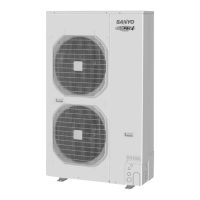2
2-2
2-1. Preparing for Test Run
Before attempting to start the air conditioner,
check the following:
(1) All loose matter is removed from the cabinet espe-
cially steel filings, bits of wire, and clips.
(2) The control wiring is correctly connected and all
electrical connections are tight.
(3) The protective spacers for the compressor used for
transportation have been removed. If not, remove
them now.
(4) The transportation pads for the indoor fan have
been removed. If not, remove them now.
(5) The power has been supplied to the unit for at least
5 hours before starting the compressor. The bottom
of the compressor should be warm to the touch and
the crankcase heater around the feet of the compre-
ssor should be hot to the touch. (Fig. 2-1)
Fig. 2-1
(6) Both the gas and liquid tube service valves are
open. If not, open them now. (Fig. 2-2)
Fig. 2-2
(7) Request that the customer be present for the test
run. Explain the contents of the instruction manual,
and then have the customer actually operate the
system.
(8) Be sure to give the instruction manual and warranty
certificate to the customer.
(9) When replacing the control PCB, be sure to make
all the same settings on the new PCB as were in
use before replacement.
The existing EEPROM is not changed, and is conn-
ected to the new control PCB.
X, XM, T, U, US, D Types
2-2. Caution
This unit may be used in a single-type refrigerant
system where 1 outdoor unit is connected to 1
indoor unit, and also in a system where 1 outdoor
unit is connected to multiple indoor units
(maximum 4).
* If multiple indoor units are used, also refer to “2-8.
System Control”.
The indoor and outdoor unit control PCB utilizes
a semiconductor memory element (EEPROM).
The settings required for operation were made at
the time of shipment.
Only the correct combinations of indoor and out-
door units can be used.
This test run section describes primarily the pro-
cedure when using the wired remote controller.
2-3. Test Run Procedure
YES
YES
YES
NO
NO
NO
Fig. 2-3
(Power must be turned ON at least
5 hours before attempting test run)
Power mains switch
ON
Liquid tube
Gas tube
Recheck the items to check
before the test run.
Check the combination (wiring) of
indoor and outdoor units.
(See 2-8-1 to 5)
(See 2-4)
Is system “single-type”?
(1 indoor unit is connected
to 1 outdoor unit and remote
controller)
Is group control with
multiple outdoor units used?
Turn ON the indoor and
outdoor power.
Indicate (mark) the
combination number.
(See 2-8-5)
Automatic
address
Set the remote controller to
“test run”.
(See 2-5)
Can
operation be
started?
Return the remote controller
to normal control.
Turn ON the
indoor and
outdoor power.
(Automatic
Address)
(See 2-8-3)
Setting the Outdoor
Unit System
Address
Set the outdoor
unit system
address.
(See 2-8-4)
Automatic Address
Setting
Use the remote
controller to
perform automatic
address setting.
Refer to “Table of Self-
Diagnostic Functions”
to check the system.
In addition, refer to
2-8-1 to 5 and correct
any items that need to
be corrected.
Note: Check the indoor-side
drainage.
(*1) Required for
simultaneous-operation
multi systems and for
group control.
(*1)
SM830161Book.indb2SM830161Book.indb2 2008/06/039:09:022008/06/039:09:02

